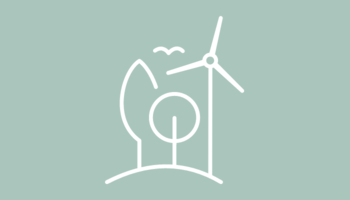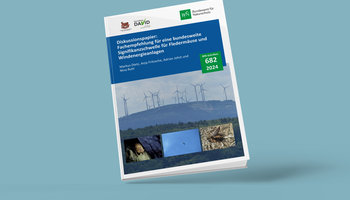Contact
PAN Planungsbüro für angewandten Naturschutz GmbH
Rosenkavalierplatz 8
81925 Munich
Dr. Angelika Meschede
Tel.: +49 89 1228569-0
angelika.meschede(at)avoid-unrequested-mailsgmail.com
Wind turbines present a potential threat to migrating bats. However, there is very little known about their migration routes, so these cannot be taken into account when planning wind turbines. This pilot study assesses the available data on the seasonal occurrence of bats, evaluates research methods for studying migration and supplies results from field studies of the Noctule bat and Nathusius' pipistrelle. The project has already been completed. It was not possible to verify specific migration corridors within the scope of this study.
Bats migrate over long distances and can run into danger from wind turbines along the way. This research project therefore investigates the migratory behaviour of bats from the following angles:
In the phenological analyses, the spatial and temporal distribution of the four species that migrate long distances were strikingly illustrated over an area of approx. 1,000 km (Germany, Switzerland and Austria) through the course of the year. The area represents a significant proportion of the Central European migration area. Almost 70,000 observations at almost 20,000 locations were compiled from literature, the bat coordination centre's data bases, natural history museums, ringing stations, nature conservation authorities and organisations, the Swiss Bat Conservation Foundation (Schweizer Stiftung Fledermausschutz) and other experts, and analysed and entered into the UTM grid maps in ten day periods.
The project team used an acoustic transect along the ridge of the Thuringian Forest and the adjacent plain to investigate flying activity of Nathusius' pipistrelle and common noctule bats at twelve sites over several weeks in the spring and autumn migration periods using automatic call recordings in order to answer the questions:
The functionality of light-sensitive geolocators was tested on three bat species for the first time in relation to bat migration. This addressed the following key questions:
To test this, two types of locators with differing light sensitivity were used for short-term tests and the more powerful type also in a long-term test by using a specially developed collar on the animal in the wild.
The telemetry was designed in such a way that, at the start of the common noctule's spring migration, data points could be collected on the bats' positions as continuously as possible over as long a period as possible. This would enable the collection of information over the exact route taken and any detours during the start of the migration. The starting point was an overwintering location in the north of Switzerland. The main questions were:
In addition, isotope analyses from fur samples of almost 100 individuals provided information on the origin of the northern Swiss wintering population.
Migration of N. leisleri and P. nathusii takes place over a large distance. By contrast there is little population movement in N. noctula. A staggered movement of parts of the population which cannot be picked up in the data could hide larger movements. The migration pattern of V. murinus is more complex than supposed: the amount of data on this species is still too small.
The species appeared at 12 recording stations during the spring and autumn migrations, with two peaks visible everywhere in spring for N. noctula and P. nathusii. Individual identifiable migration nights are synchronous in all areas.
Migrating bats do not avoid mountains. Individual valleys do not play any special role and there is no preference for specific habitats or types of terrain. Activity in the three valleys in the German Central Uplands was similar and was due almost entirely to migration events. The high level of activity at the reference site (plain) was probably also due to animals looking for food and roosting sites and the autumn mating.
Short-term study: a low-intensity light chip can be used for N. noctula but a stronger type has to be used for N. leisleri and P. nathusii. A long-term study has not been successful so far.
In 2013 migration of female noctules from the overwintering quarters took place between the start of May and mid-June, in 2014 on almost exactly the same day. In two years the animals flew off in various directions between north-east and east. The route actually taken by two animals during the first half of the first migration night was documented relatively precisely: one animal moved away in a number of loops and "detours", thus increasing the actual distance flown. The migration route covered is therefore potentially considerably longer than a direct line between the winter quarters and the nursery. "Detours" can be explained by e.g. the search for food.
The project results can be used in planning. With reference to wind energy in particular, the following results should be taken into account:
PAN Planungsbüro für angewandten Naturschutz GmbH
Rosenkavalierplatz 8
81925 Munich
Dr. Angelika Meschede
Tel.: +49 89 1228569-0
angelika.meschede(at)gmail.com
NACHTaktivBiologen für Fledermauskunde GbR
Häßlerstr. 99
99099 Erfurt
Inken Karst, Wigbert Schorcht & Martin Biedermann
anfrage(at)nachtaktiv-biologen.de
www.nacht-aktiv.net
SWILD – Urban Ecology & Wildlife Research
Wuhrstr. 12
CH-8003 Zürich
Dr. Fabio Bontadina
Tel.: +41 450 68 05 / 06
fabio.bontadina(at)swild.ch
www.swild.ch
Museum für Naturkunde – Leibniz Institute for Evolution and Biodiversity Science
Invalidenstr. 43
10115 Berlin
PD Dr. Frieder Mayer
Tel.: +49 30 2093-8702
Frieder.Mayer(at)mfn-berlin.de
Koordinationsstelle für Fledermausschutz in Nordbayern
(Coordination office for bat protection in Northern Bavaria)
Friedrich-Alexander-Universität Erlangen-Nürnberg
Department Biologie – Chair of Animal Physiology
Staudtstr. 5
91058 Erlangen
Matthias Hammer
Tel.: +49 9131 852-8788
mhammer(at)biologie.uni-erlangen.de
Koordinationsstelle für Fledermausschutz in Südbayern
(Coordination office for bat protection in Southern Bavaria)
Hermann-Löns-Str. 4
84478 Waldkraiburg
Dr. Andreas Zahn
Tel.: +49 8638 86117
Andreas.Zahn(at)iiv.de
KFFÖ Koordinationsstelle für Fledermausschutz und -forschung in Österreich
(Coordination Office for Bat Protection and Research in Austria)
Fritz-Störk-Str. 13
A-4060 Leonding
Dr. Guido Reiter
Tel.: +43 676 7530634
Guido.Reiter(at)fledermausschutz.at
Federal Agency for Nature Conservation (BfN)
FG II 1.1 Zoological species protection
Konstantinstr. 110, 53179 Bonn
Sekretariat-II-1(at)BfN.de
03.04.2024
Weiter

03.04.2024
Weiter

19.03.2024
Weiter
